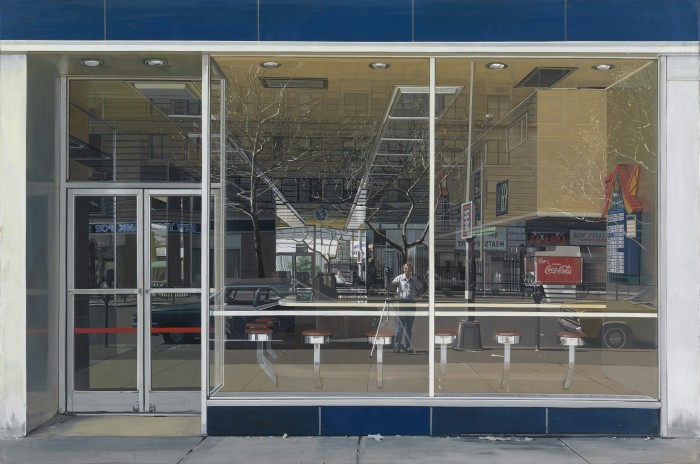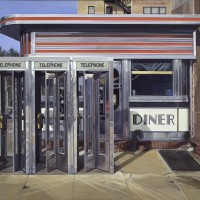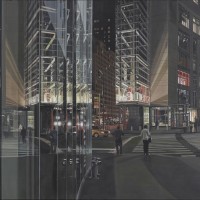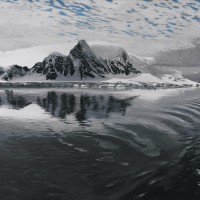Layers upon layers: the multifaceted reality of Richard Estes

Richard Estes, Double Self-Portrait, 1976, oil on canvas, The Museum of Modern Art, New York. Mr. and Mrs. Stuart M. Speiser Fund, 1976. © Richard Estes, courtesy Marlborough Gallery, New York. Image © The Museum of Modern Art/Licensed by SCALA/Art Resource, NY
The first comprehensive exhibition of paintings by the master of contemporary realism is on display at the American Art Museum. “Richard Estes’ Realism” features 46 paintings spanning Estes’ 50-year career, including a number of works from private collections that are rarely seen publically. The exhibition also shows, for the first time, Estes’ panoramic landscape paintings and water scenes alongside his more famous cityscapes, offering new insights into Estes’ particular vision.
Estes is considered the foremost practitioner of the international group of artists known loosely as photorealists and has been celebrated for more than 45 years as one of the premier painters of American cityscapes. Born in 1932 and raised in central Illinois, Estes studied at the School of the Art Institute of Chicago from 1952 to 1956. In 1958, he moved to New York City, where he has lived ever since. For several years, he worked in commercial publishing and advertising as a paste-up, layout and illustration artist. In the mid-1960s, Estes began to paint from his own photographs, developing paintings that are rooted in Dutch, Venetian and American representations of urban architecture. In 1978, the Museum of Fine Arts in Boston organized the first major career survey of his work. Estes’ work has been shown frequently by the Marlborough Gallery and the Allan Stone Gallery, and solo exhibitions have toured Europe and Asia.
Part of Estes’ unmistakable singularity has to do with the fact that he has been making his own photographs since he was a young boy. Estes’ compositions—amalgamations of the multiple photographs he takes for each composition—are dramatic and complex to the point of abstraction. He layers and merges multiple viewpoints to create dense and detailed scenes that reward the viewer with careful looking. His images are more sophisticated than they appear to be at first glance.
“I think of the photograph as a sketch to be used, not a goal to be reached,” said Estes.
Though figures are often present in his work, they are—like most passersby in public spaces—anonymous and uncommunicative. His seemingly effortless technical finesse captures the intricate geometries of the city, the subtle contours and nuanced tones of natural landscapes and the shimmering fluidity of water. Estes’ realism is a compelling record of the appearance of urban and natural environments in the late 20th and early 21st century.
The exhibition is the first complete overview of Estes’s work in the U.S. since 1978. It explores the full range of Estes’ career as a painter, with works from the late 1960s to 2013. Paintings in the exhibition balance Estes’ interest in cities—London, New York, Paris, Tokyo—with luminous sunlit scenes of Venice and Antarctica as well as his explorations of the Maine coast and the woods on Mount Desert Island, where he has spent part of each year since the late 1970s. Recently, Estes has captured nocturnal images of New York City, and several examples are on display. A number of Estes’ rare portraits and self-portraits also are included in the exhibition.
- Richard Estes, Diner, 1971, oil on canvas, Hirshhorn Museum and Sculpture Garden, Smithsonian Institution, Museum purchase 1977. © Richard Estes, courtesy Marlborough Gallery, New York. Photo by Lee Stalsworth
- Richard Estes, Columbus Circle at Night, 2010, oil on canvas, Colby College Museum of Art, The Lunder Collection. © Richard Estes, courtesy Marlborough Gallery, New York
- Richard Estes, Antarctica, 2007, oil on canvas, Crystal Bridges Museum of American Art, Bentonville, Arkansas. © Richard Estes, courtesy Marlborough Gallery, New York. Photo by Dwight Primiano
Posted: 1 October 2014
- Categories:











